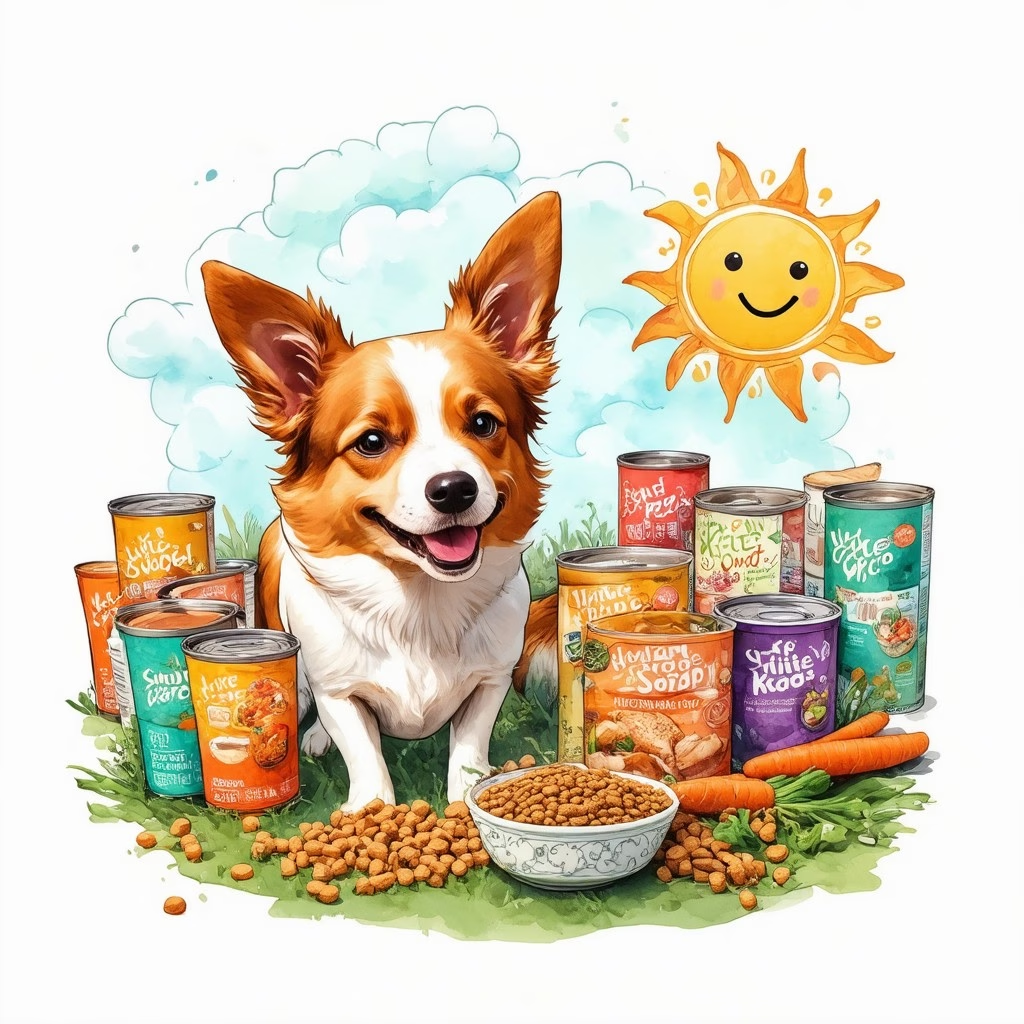Key Takeaways
- Choosing the best dog food ensures your dog’s happiness and health, emphasizing quality ingredients and balanced nutrition.
- Incorporate healthy human foods like cooked eggs, pumpkin, and green beans to enhance your dog’s diet.
- Consult with veterinarians for tailored dog food recommendations based on your pet’s unique needs.
- Understand the 3% Rule in dog food labeling to make informed choices about ingredient quality.
- Stay informed about dog food recalls to protect your pet from harmful products.
- Utilize effective shopping strategies, such as local stores and online subscriptions, to find affordable dog food options.
Choosing the right dog food is crucial for ensuring your furry friend remains happy and healthy. With so many options available, it can be overwhelming to determine what is truly the best food to feed your dog. In this comprehensive guide, we will explore essential topics such as understanding your dog’s nutritional needs, the importance of quality ingredients, and the differences between dry and wet dog food. We will also delve into expert recommendations from veterinarians, affordable options for budget-conscious pet owners, and even homemade dog food recipes that can provide nutritious alternatives. Additionally, we will discuss the critical issue of dog food recalls and how to stay informed about safety concerns. Whether you’re looking for the best dog food brands or tips on proper storage and delivery options, this article will equip you with the knowledge to make informed decisions for your beloved pet.
Understanding Nutritional Needs for Dogs
When considering the best food to feed your dog, it’s essential to focus on high-quality, nutritious options that promote overall health. Dogs, like humans, require a balanced diet that includes proteins, fats, carbohydrates, vitamins, and minerals. Understanding these nutritional needs is crucial for maintaining your dog’s health and well-being.
The Role of Protein in Dog Nutrition
Protein is a vital component of your dog’s diet, as it helps build and maintain muscle mass. High-quality protein sources include:
- Cooked, Unseasoned Chicken: A great source of protein, chicken helps build and maintain muscle mass. Ensure it is cooked thoroughly and free of bones.
- Cooked, Unseasoned Turkey: Similar to chicken, turkey is lean and packed with protein. It can be a good alternative for dogs with chicken allergies.
- Cooked, Unseasoned Fish: Fish like salmon and sardines are rich in omega-3 fatty acids, which support skin and coat health. Always remove bones and avoid fish high in mercury.
Incorporating Healthy Human Foods into Your Dog’s Diet
In addition to commercial dog food, incorporating certain human foods can enhance your dog’s nutrition. Here are some safe options:
- Cooked, Unseasoned Eggs: Eggs are a complete protein source and contain essential amino acids. They can be scrambled or boiled, but should not be seasoned.
- Cooked Pumpkin: Rich in fiber and vitamins, pumpkin aids digestion and can help with weight management. Ensure it is plain and not spiced.
- Cooked Green Beans: Low in calories and high in fiber, green beans are a healthy snack that can help dogs feel full.
- Cooked Carrots: Carrots are crunchy and rich in beta-carotene, promoting good vision and dental health. They can be served raw or cooked.
- Cooked Spinach: Spinach is packed with vitamins and minerals, but should be given in moderation due to its oxalic acid content, which can interfere with calcium absorption.
- Sliced Apples (In Moderation): Apples provide vitamins A and C, and are a good source of fiber. Remove the seeds and core before feeding.
For optimal canine nutrition, it’s crucial to consult with a veterinarian or a pet nutritionist to tailor a diet that meets your dog’s specific needs. Incorporating these foods can enhance your dog’s diet, but they should complement a balanced commercial dog food that meets AAFCO standards. For more detailed guidance on pet nutrition, consider resources from veterinary nutritionists or reputable pet health organizations like the ASPCA Dog Food Guide.

Understanding Nutritional Needs for Dogs
When it comes to selecting the best food for your dog, understanding their nutritional needs is crucial. Dogs require a balanced diet that includes proteins, fats, carbohydrates, vitamins, and minerals. Each dog’s needs can vary significantly based on factors such as age, breed, size, and health conditions. For instance, puppies need food that supports their rapid growth and development, while older dogs may require diets that are easier to digest and lower in calories.
Here are some top recommendations based on various criteria:
- Best for Puppies: Hill’s Science Diet Puppy Small Bites Dry Dog Food – This formula supports healthy growth and development, providing balanced nutrition with high-quality protein and DHA from fish oil for brain and eye development.
- Best Overall: Royal Canin Small Breed Adult Dry Dog Food – Tailored for small breed dogs, this food offers a blend of nutrients that support heart health and maintain an ideal weight.
- Best Subscription: The Farmer’s Dog Subscription Dog Food – This service delivers freshly made, human-grade dog food tailored to your dog’s specific dietary needs.
- Best for Sensitive Stomachs: Purina Pro Plan Adult Sensitive Skin & Stomach Dry Dog Food – Formulated with salmon as the first ingredient, this food is gentle on the digestive system.
- Best Food for Active Dogs: Blue Buffalo Life Protection Formula Adult Dog Food – This high-protein formula is ideal for active dogs, featuring real meat as the first ingredient.
Always consult with your veterinarian to ensure the chosen dog food meets your dog’s unique dietary requirements. For more information on pet nutrition and wellness, consider resources from the American Kennel Club and the FDA Animal & Veterinary.
The Importance of Quality Ingredients in Dog Food
Quality ingredients play a vital role in your dog’s overall health and well-being. When selecting dog food, it’s essential to look for brands that prioritize high-quality, natural ingredients. Foods that contain real meat, whole grains, and fresh fruits and vegetables are generally more nutritious than those filled with fillers and artificial additives.
Additionally, understanding the ingredient list can help you avoid potential allergens and ensure your dog receives the necessary nutrients. For example, if your dog has food allergies, consider options like Purina Pro Plan for sensitive stomachs or specialized formulas for dogs with allergies.
For more insights on choosing the right dog food, you can refer to the Dog Food Advisor, which provides detailed reviews and recommendations on various dog food brands.
What is the 3 Rule on Dog Food?
The 3% Rule in dog food labeling refers to the requirement that if a pet food product includes a named ingredient (such as chicken, beef, or lamb) in its title, that ingredient must constitute at least 3% of the total weight of the product. This rule allows manufacturers to market their products as containing specific ingredients, enhancing their appeal to consumers who prioritize certain components in their pets’ diets.
For example, if a dog food is labeled “with chicken,” it must contain a minimum of 3% chicken. This regulation is part of the broader guidelines established by the Association of American Feed Control Officials (AAFCO), which oversees pet food labeling standards to ensure transparency and accuracy for consumers.
Understanding the 3% Rule is crucial for pet owners who want to make informed decisions about their dog’s nutrition. It emphasizes the importance of reading labels carefully and recognizing that just because an ingredient is mentioned, it does not necessarily mean it is a primary component of the food.
For more detailed insights into pet nutrition and ingredient transparency, refer to FDA Animal & Veterinary and resources from the American Kennel Club.
How to Choose the Right Dog Food Based on the 3-Rule
Choosing the right dog food involves more than just understanding the 3% Rule; it requires a comprehensive approach to your dog’s nutritional needs. Here are some key factors to consider:
- Ingredient Quality: Look for high-quality ingredients that provide essential nutrients. Avoid brands of dog food that use fillers or artificial additives.
- Specific Needs: Consider your dog’s age, size, and health conditions. For instance, dogs with allergies may require specialized food for dogs with allergies.
- Brand Reputation: Research dog food brands and read reviews. Websites like Dog Food Advisor can provide insights into the best dog food brands and those to avoid.
- Consult Your Vet: Always consult with your veterinarian when selecting food for your dog, especially if they have specific dietary needs or sensitivities.
By applying the 3% Rule and considering these factors, you can make informed decisions that contribute to your dog’s overall health and well-being.
What’s a Good Affordable Dog Food?
When searching for affordable dog food that maintains quality nutrition, consider the following top recommendations based on expert reviews and nutritional analysis:
- Best Dry Dog Food: Natural Balance Health Protection Chicken, Brown Rice, and Pumpkin
This formula is designed to support overall health with a blend of high-quality protein, digestible carbohydrates, and essential vitamins. It is particularly beneficial for dogs with sensitive stomachs. Natural Balance is known for its commitment to balanced nutrition, making it a reliable choice for budget-conscious pet owners. - Best Wet Dog Food: Hill’s Science Diet Adult Beef and Barley
This wet food option is formulated with high-quality protein to support muscle maintenance and is enriched with antioxidants for a healthy immune system. The combination of beef and barley provides a tasty meal that dogs love while ensuring they receive essential nutrients. Hill’s Science Diet is often recommended by veterinarians for its scientifically formulated recipes. - Best for Sensitive Stomachs: Purina Pro Plan Sensitive Skin and Stomach Salmon and Rice
This formula is specifically crafted for dogs with dietary sensitivities, featuring salmon as the primary ingredient, which is a great source of omega fatty acids for skin and coat health. The inclusion of rice helps in digestion, making it a gentle option for sensitive stomachs. Purina Pro Plan is recognized for its research-backed formulations.
When selecting dog food, it’s essential to consider your dog’s specific dietary needs, including any allergies or sensitivities. Always consult with a veterinarian to ensure the chosen food aligns with your dog’s health requirements. Additionally, for those interested in holistic approaches to pet care, exploring resources on wellness coaching for pets may provide further insights into maintaining your dog’s health and well-being.
Where to Shop Dog Food on a Budget
Finding affordable dog food doesn’t have to be a challenge. Here are some effective strategies to help you shop smart:
- Local Pet Stores: Many local pet stores offer discounts on bulk purchases or loyalty programs that can save you money over time.
- Online Retailers: Websites like Walmart and Chewy often have competitive prices and regular sales on popular dog food brands.
- Subscription Services: Consider using a dog food delivery service that offers subscription options. These services frequently provide discounts for recurring orders.
- Coupons and Promotions: Keep an eye out for coupons in local newspapers or online coupon sites. Brands often run promotions that can significantly reduce your costs.
By utilizing these shopping strategies, you can find quality dog food that fits your budget while ensuring your furry friend receives the nutrition they need.

What Dog Food Do Most Vets Recommend?
When it comes to selecting the best dog food, veterinarians play a crucial role in guiding pet owners toward nutritious options tailored to their dogs’ specific needs. Understanding what dog food brands are commonly recommended can help you make informed decisions for your furry friend.
Vet-Recommended Dog Food Brands
Veterinarians commonly recommend several high-quality dog food brands based on nutritional standards and individual dog needs. Here are the key recommendations:
- “Big Four” Brands: The most frequently recommended brands by vets include Purina Pro Plan, Hill’s Science Diet, Royal Canin, and Eukanuba. These brands are recognized for their adherence to AAFCO (Association of American Feed Control Officials) standards, ensuring balanced nutrition.
- Tailored Recommendations: Vets often customize their recommendations based on specific health needs. For example, dogs with allergies or sensitive stomachs may benefit from specialized formulas like Purina Pro Plan Sensitive Skin & Stomach or Hill’s Prescription Diet.
- Importance of Ingredients: High-quality dog food should prioritize animal protein sources, such as chicken or beef, and avoid excessive fillers, artificial preservatives, and by-products. Ingredients should be clearly listed, with named meat sources at the top of the ingredient list.
- Beyond the “Big Four”: While the major brands are popular, other options are gaining traction. Brands like Iams and fresh dog food services such as The Farmer’s Dog are also recommended for their quality ingredients and tailored nutrition.
- Consult Your Vet: The best approach is to have a detailed discussion with your veterinarian to determine the most suitable food for your dog’s unique health requirements and lifestyle.
- Recent Trends: There is a growing trend toward fresh and raw dog food diets, which some veterinarians endorse for their nutritional benefits. However, it’s crucial to ensure these diets are balanced and meet AAFCO standards.
The Role of Dog Food Advisors in Choosing the Right Food
In addition to veterinarians, dog food advisors can provide valuable insights into selecting the best food for your pet. These experts analyze various dog food brands and their ingredients, helping you navigate the vast market of dog foods.
- Ingredient Analysis: Dog food advisors evaluate the quality of ingredients in different brands, ensuring that your dog’s food is nutritious and free from harmful additives.
- Personalized Recommendations: Based on your dog’s specific dietary needs, such as allergies or sensitivities, a dog food advisor can suggest suitable options, including homemade dog food recipes or specialized commercial brands.
- Staying Informed: Advisors often keep up with the latest trends and recalls in the pet food industry, ensuring that you are aware of any potential issues with the dog food you choose.
For more information on dog food recalls and safety, you can visit the FDA Animal & Veterinary page.
Dog Food Recalls: What You Need to Know
Understanding dog food recalls is crucial for ensuring the safety and health of our beloved pets. Dog food recalls occur when a product is found to contain harmful ingredients or contaminants that could pose a risk to dogs. Staying informed about these recalls helps pet owners make safer choices regarding the food they provide for their dogs.
Understanding Dog Food Recalls and Safety
Dog food recalls can happen for various reasons, including contamination with harmful bacteria, the presence of foreign materials, or incorrect labeling of ingredients. The FDA Animal & Veterinary provides updates on recalls and safety alerts, making it a reliable resource for pet owners. Regularly checking for dog food recalls ensures that you are not feeding your dog potentially dangerous products.
In recent years, several high-profile dog food recalls have highlighted the importance of vigilance. For instance, brands like Purina and others have faced recalls due to contamination issues. It’s essential to familiarize yourself with the brands of dog food you choose and to stay updated on any recalls that may affect them.
How to Stay Informed About Dog Food Recalls
To keep your dog safe, consider the following strategies for staying informed about dog food recalls:
- Subscribe to Alerts: Sign up for email alerts from the FDA or other pet food safety organizations to receive timely updates on recalls.
- Follow Reputable Sources: Websites like Dog Food Advisor provide comprehensive information on dog food recalls and safety ratings for various brands.
- Check Retailer Notifications: Many pet food retailers will notify customers of recalls, so keep an eye on communications from stores where you purchase dog food.
- Join Pet Owner Communities: Engaging with online forums and social media groups can help you stay informed about the latest news and experiences shared by other dog owners.
By actively monitoring dog food recalls, you can ensure that you are providing safe and healthy food for your dog, minimizing the risk of health issues related to contaminated products.
Dog Food Storage and Delivery Options
Best Practices for Dog Food Storage
Proper storage of dog food is essential to maintain its freshness and nutritional value. Here are some best practices to consider:
1. **Use Airtight Containers**: Store dry dog food in airtight containers to prevent exposure to air, moisture, and pests. This helps preserve the quality and prevents spoilage. A large dog food container is ideal for bulk storage.
2. **Keep in a Cool, Dry Place**: Dog food should be stored in a cool, dry area away from direct sunlight. Heat and humidity can degrade the food’s quality, leading to potential spoilage or loss of nutrients.
3. **Check Expiration Dates**: Always check the expiration date on the packaging before purchasing and using dog food. Consuming expired food can lead to health issues for your pet.
4. **Use Within Recommended Timeframes**: Once opened, dry dog food should ideally be used within six weeks to ensure optimal freshness. For homemade dog food, consume within a few days if refrigerated.
5. **Label Containers**: If you transfer dog food to a different container, label it with the purchase date and expiration date to keep track of freshness.
For more detailed information on safe storage practices, you can refer to the [ASPCA Dog Food Guide](https://www.aspca.org/pet-care/dog-care/dog-food).
Exploring Dog Food Delivery Services and Subscription Options
With the rise of convenience in pet care, dog food delivery services have become increasingly popular. Here are some options to consider:
1. **Subscription Services**: Many brands offer subscription services that deliver dog food directly to your door at regular intervals. This ensures you never run out of food and can often save you money. Brands like [Purina](https://www.purina.com/) and [Dog Food Advisor](https://www.dogfoodadvisor.com/) provide various subscription options tailored to your dog’s needs.
2. **Local Delivery Options**: Check with local pet stores or supermarkets for delivery services. Many retailers now offer online ordering with home delivery, making it easy to get your dog’s food without leaving home.
3. **Fresh Dog Food Delivery**: For those interested in a healthier diet for their pets, fresh dog food delivery services provide meals made from high-quality ingredients. These services often customize meals based on your dog’s dietary needs, including options for dogs with sensitive stomachs or allergies.
4. **Cost-Effective Choices**: While convenience is key, it’s also important to find affordable dog food options. Many delivery services offer competitive pricing, and you can often find discounts for first-time subscribers.
By utilizing these storage and delivery options, you can ensure that your dog always has access to fresh, nutritious food. For more insights on dog food delivery, visit [Wellness Coaching For Life](https://wellnesscoachingforlife.com/dog-food-delivery).













